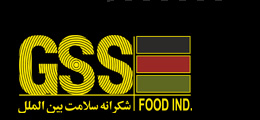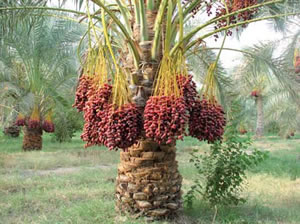An old Arabic legend tells of the Date palm’s creation: “After God had finished molding Man from Earth; He took the remaining material and shaped it into a date palm which he placed in the Garden of Paradise”.
Since before the existence of Man over 50,000 years ago – Date palms and their fruit have been instrumental to humans. The Mesopotamians recognized the tree’s versatility and value; its sweet fruit became an essential part of their diet. The palm offered “three hundred and sixty” uses including needles, thread, lumber, mattresses, rope, baskets and other household items; as well as food and beverage.
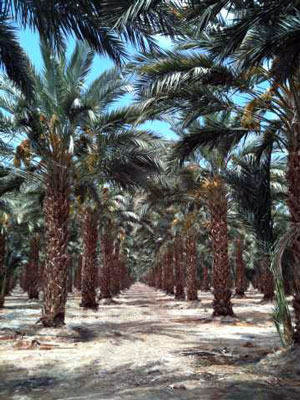 Feet in Water, Head in Fire
Feet in Water, Head in Fire
Date palms are said to thrive with their “feet in water and heads in the sun” because they need plenty of ground water to drink, but high heat and arid weather to produce fruit.
Growing and Harvesting Dates
Commercially grown date palms are from offshoots to ensure desired dates variety qualities. The scientific name, Phoenix dactylifera, refers to feather palms that may grow more than 100 feet and live more than 200 years.
Pollination
Date palms are dioecious – having male and female trees. Females bear the fruit, males produce pollen. Commercial date palm gardens typically have one male and fifty female trees planted per acre. Natural pollination by wind is not efficient. Hand pollination is one of the oldest agricultural techniques. Using the mechanical pollination method, pollen collected from male flowers is mixed with a carrier such as flour, and is dusted on just-opened female flower clusters.
Date Palm Historical Information
Date palms were one of the first plants cultivated by man. The first written records of date palms being grown and harvested are from about 5000 years ago in ancient Mesopotamia (current day Iraq) along the Tigris and Euphrates rivers. Date palms were also used 6000 years ago near Ur in Southern Iraq in the construction of the temple of the moon god. Archaeological research into ancient dwelling sites of Akadians, Sumerians, and Babylonians has shown that houses of these ancient peoples were roofed with date palm trunks and fronds.
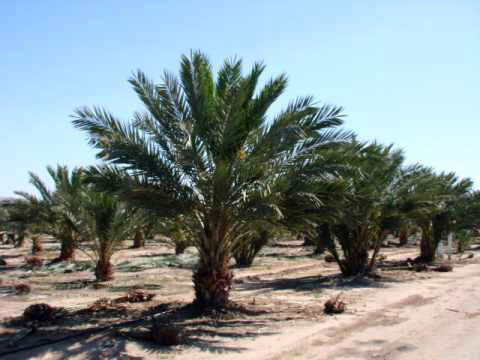 The scientific name for the date palm is phoenix dactylifera, and it is popularly known simply as the date palm. Although commonly referred to as a “palm tree”, date palms are actually a true palm and not a tree. All palms, including the date palm, belong to a group of plants that are known as monocotyledons which include grasses, bamboos, hostas, lilies, daffodils, irises, palms, and orchids.
The scientific name for the date palm is phoenix dactylifera, and it is popularly known simply as the date palm. Although commonly referred to as a “palm tree”, date palms are actually a true palm and not a tree. All palms, including the date palm, belong to a group of plants that are known as monocotyledons which include grasses, bamboos, hostas, lilies, daffodils, irises, palms, and orchids.
There are many other palms that produce edible drupes or dates, however their “dates” are almost all seed with very little flesh and most are quite small. Only phoenix dactylifera – the true “date palm” produces the large edible dates that are cultivated and sold today. The female phoenix dactylifera palm yields dates that measure from 1 to 3 inches long with varying degrees of sweetness. There are hundreds of named varieties of phoenix dactylifera date palms, and one of the most famous and actually the world’s best Mazafati dates is rotab korma dates from the city of BAM. Zahidi date palm, and the Rabbi date palm are another types of the dates. Each of these date palm varieties produce delicious dates with distinct differences in flavor, sweetness, moisture content, and size.
 Phoenix dactylifera date palms have been cultivated by man since the begining of recorded history. The name of the ancient land of Phoenicia actually means “land of palms”, and many ancient Phoenician coins have images of date palms!
Phoenix dactylifera date palms have been cultivated by man since the begining of recorded history. The name of the ancient land of Phoenicia actually means “land of palms”, and many ancient Phoenician coins have images of date palms!
Date palms are mentioned in the bible, and their leaves were carried as symbols of victory by kings thousands of years ago. Date palm leaves were also used to hail Jesus during His entry into Jerusalem. Today Christian’s have Palm Sunday, and Muslims break their Ramadan fast each night by eating a date. Islam regards the date palm tree as the tree of life, and ancient traditions place it in the Garden of Eden. The Prophet Mohammed said “There is among the trees, one which is blessed – it is the date palm, for it was created from the earth left over from the creation of Adam.”
The date palm is not as well known in the USA and Europe, but it is very important in the Middle East and Northern Africa because the date palm grows well in the dry desert heat of these areas.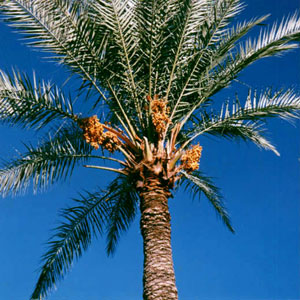 In the past, dates had a very important role in these desert regions as the staple food crop. It was comparable to rice, wheat, and potatoes in other cultures! Even today the date palm is still the most important food plant of the great deserts of the Old World. The date palm’s importance is not only for the food value of the dates themselves, but also for the partial shade of the date palm under which it was possible to cultivate other fruit trees that could not exist if exposed to the full dry heat of the desert sun.
In the past, dates had a very important role in these desert regions as the staple food crop. It was comparable to rice, wheat, and potatoes in other cultures! Even today the date palm is still the most important food plant of the great deserts of the Old World. The date palm’s importance is not only for the food value of the dates themselves, but also for the partial shade of the date palm under which it was possible to cultivate other fruit trees that could not exist if exposed to the full dry heat of the desert sun.
For commercial dates production, the top dates producing regions today are the Middle East and North Africa. Iraq was the largest producer of the dates, although today Iran is thought to be the largest producer. Saudi Arabia is another major producer of dates and their national symbol has date palms. Libya, Tunisia, and Algeria produce large commercial quantities of dates, and these countries also have date palms on their stamps and currency.
Dates are also grown in some areas of Mexico and in South America, as well as in Australia, Western China, Western India, and in Southern Pakistan. According to the World Food and Agricultural Organization, there are an estimated 100 million date palm trees worldwide. An estimated 60% of all date palms are grown in the Middle East and North Africa.
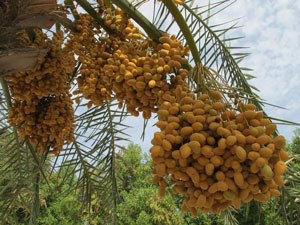 Male Date Palm Flowers, Date Palm Pollen, and Rotab Mazafati Date Palm Pollination
Male Date Palm Flowers, Date Palm Pollen, and Rotab Mazafati Date Palm Pollination
Phoenix dactylifera date palms are dioecious, meaning that there are both male date palms and female date palms. The male date palm has flowers that produce the pollen, and the female date palm has flowers which will become dates, if they are pollinated.
Bees are strongly attracted to date palm pollen. As you can see in the photo at left, there are a few dozen bees collecting pollen on the male date palm flower. Date palms can pollinate naturally by wind, bees and other insects, but proximity of the male date palms to the females is crucial for this open pollination to occur successfully, and dates production from open polination is usually very low. Artificial pollination increases date production substantially. Artificial pollination of date palms is performed using the date palm pollen from male date palm flowers to polinate the female date palm flowers.The photo at left shows a male date palm flower one day after opening.
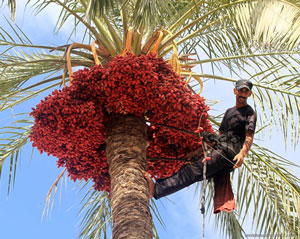 The flower stalks of both male and female date palms are produced inside a spathe. The spathe emerges from the axils of the leaves in early spring in mature date palms. The date palm flowers form within the long stout spathe which, on bursting, exposes many thickly crowded floral branchlets inside which are thicker and shorter in the male date palm inflorescence, and the branchlets are long and slender in female date palm inflorescence. Adult female date palms produce from 5 – 20 spathes in early spring. The male flowers are borne single and are waxy white, while the female flowers are borne in clusters of three and are yellowish green in colour. A male spathe that is ready to split open changes color from green to brown and it becomes slightly softer. Immediately after the spathe opens and the male inflorescence appears, these male flowers reach their maturity. Dates growers usually harvest the male flowers within a day of when the spathe splits open.
The flower stalks of both male and female date palms are produced inside a spathe. The spathe emerges from the axils of the leaves in early spring in mature date palms. The date palm flowers form within the long stout spathe which, on bursting, exposes many thickly crowded floral branchlets inside which are thicker and shorter in the male date palm inflorescence, and the branchlets are long and slender in female date palm inflorescence. Adult female date palms produce from 5 – 20 spathes in early spring. The male flowers are borne single and are waxy white, while the female flowers are borne in clusters of three and are yellowish green in colour. A male spathe that is ready to split open changes color from green to brown and it becomes slightly softer. Immediately after the spathe opens and the male inflorescence appears, these male flowers reach their maturity. Dates growers usually harvest the male flowers within a day of when the spathe splits open.
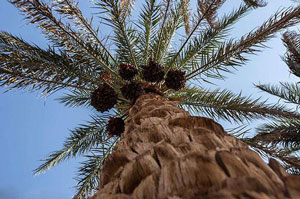 We have fresh male date palm flowers available in March and April each year for use in pollination, and also as a source of fresh date palm pollen.
We have fresh male date palm flowers available in March and April each year for use in pollination, and also as a source of fresh date palm pollen.
There are several methods of date palm polination in use today. The oldest and simplest pollination technique consists of placing an entire male flower spathe in the crown of the female date palm and leaving the pollination to wind, bees and other insects. This technique does not always yield uniform fruit sets unless if several of the male flower spathes are placed in the crown of the female date palm. This requires the availability of numerous male flower spathes.
 Successful commercial dates production requires artificial pollination to ensure good pollination. In locations where labor is relatively expensive, the pollination is mechanized. Mechanized pollination reduces the number of male date palms needed for pollination. The male/female ratio in a modern commercial date palm plantation with mechanized pollination is generally about 40 females to one male date palm. The most common technique of pollination in regions with inexpensive labor is to cut the strands of male flowers from a freshly opened male spathe and place two to three of these strands, lengthwise and in an inverted position, between the strands of the female inflorescence after some pollen has been shaken over the female inflorescence.
Successful commercial dates production requires artificial pollination to ensure good pollination. In locations where labor is relatively expensive, the pollination is mechanized. Mechanized pollination reduces the number of male date palms needed for pollination. The male/female ratio in a modern commercial date palm plantation with mechanized pollination is generally about 40 females to one male date palm. The most common technique of pollination in regions with inexpensive labor is to cut the strands of male flowers from a freshly opened male spathe and place two to three of these strands, lengthwise and in an inverted position, between the strands of the female inflorescence after some pollen has been shaken over the female inflorescence.
